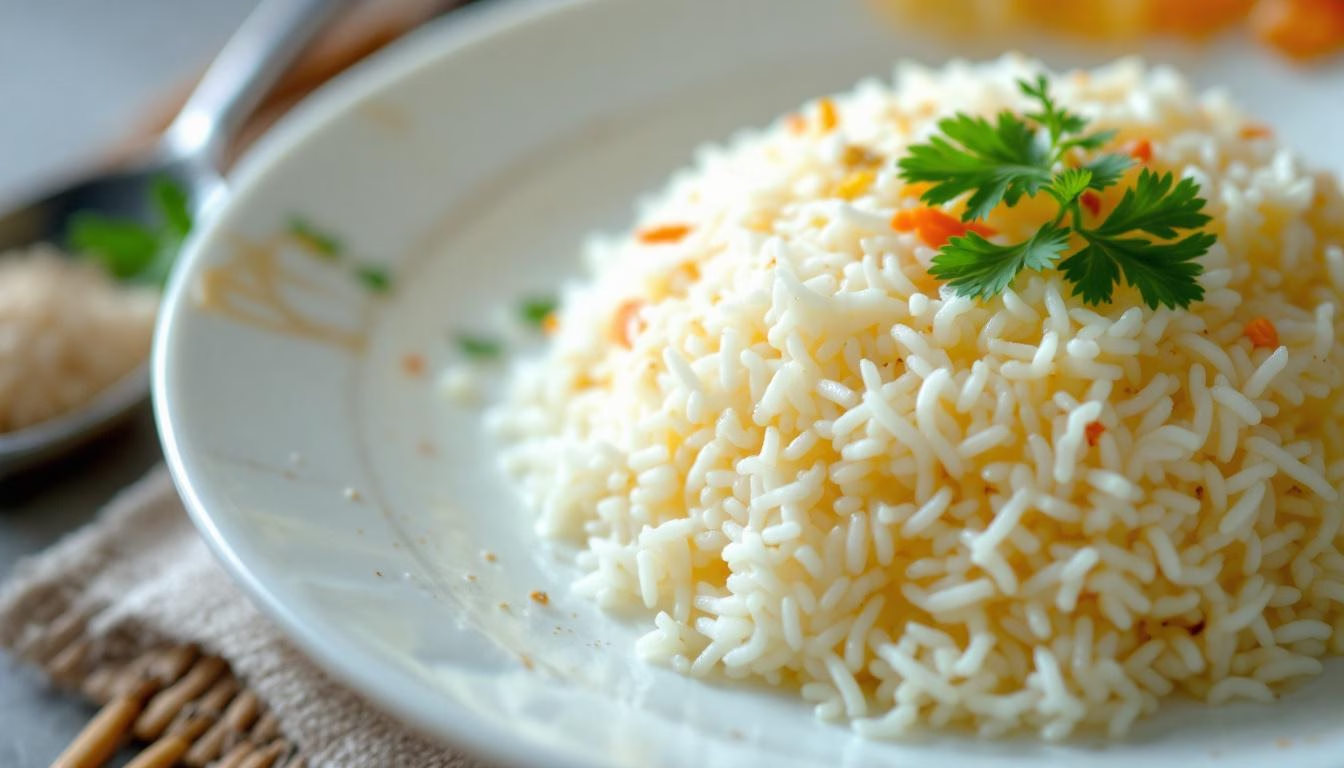Best Nasi Uduk Betawi Indonesian Coconut Rice Recipe
The Best Nasi Uduk Betawi Recipe (Indonesian Coconut Rice) Recipe That Changed My Mind About Side Dishes – I used to think rice was just rice — a bland, utilitarian backdrop for whatever protein was hogging the spotlight on my dinner plate.

Nasi Uduk Betawi (Indonesian coconut rice)
Ingredients
- 2 cups jasmine rice
- 13.5 oz. coconut milk
- 1 ⅓ cups water
- 1 full stalk lemongrass (dry external leaves and tips removed)
- 2 pandan leaves (fresh, or frozen and thawed)
- 4 Indonesian bay leaves (fresh, or dried)
- 3 thin slices of galangal
- 2 thin slices of fresh ginger
- 1 teaspoon coriander powder
- ½ teaspoon salt
- Optional: 1 full star anise
- ½ teaspoon olive oil
- ⅓ cup dry roasted peanuts
- 1 teaspoon kecap manis (or plain tamari)
Instructions
- Rinse the rice in a fine mesh strainer until the water runs clear. Transfer to a large bowl, cover with water, soak for 30 minutes, then drain.
- In a medium-sized pot, combine the drained rice, canned coconut milk, water, the lemongrass stalk (bruised with the back of a knife and cut into pieces to fit the pot), pandan leaves, Indonesian bay leaves, galangal slices, coriander powder, salt, and optional star anise. Stir to combine.
- Place the pot over medium heat and bring to a boil. Once boiling, reduce the heat to low and cover with a tight-fitting lid.
- Simmer for 15-18 minutes, or until the liquid is fully absorbed and the rice is tender.
- Once the rice is cooked, remove from the heat and let the covered pot sit for 5 minutes to steam and meld the flavors.
- While the rice is steaming, heat the olive oil in a small pan over medium heat. Add the peanuts and toss to coat. Cook 3-4 minutes, stirring frequently, until lightly toasted and fragrant.
- When the peanuts are lightly golden brown, stir in the kecap manis (or tamari) and cook for about 40 seconds until the peanuts are coated.
- To serve, fluff the rice with a fork and remove the lemongrass stalk, pandan leaves, Indonesian bay leaves, galangal slices, and optional star anise. Top the rice with the toasted peanuts.
Nutrition
Then I met nasi uduk at a tiny Indonesian restaurant tucked into a strip mall in Queens, and honestly?
It was like discovering that your quiet, unassuming coworker is actually a secret jazz pianist who moonlights as a poet.
This wasn’t just rice; this was rice with personality.
The first bite hit me with layers I wasn’t expecting: creamy coconut milk that had somehow infused every single grain, a subtle floral note that I later learned was pandan (think vanilla’s more sophisticated cousin), and this warm, almost medicinal fragrance from galangal and lemongrass that made my sinuses tingle in the best possible way.
I found myself eating spoonfuls of it straight, completely ignoring the beautifully prepared rendang sitting right next to it.
My dining companion — a friend who’d grown up eating this stuff — just smiled knowingly and said, “Yeah, that’s what good nasi uduk does to people.”
That night, I went home and immediately started researching this Nasi Uduk Betawi (Indonesian coconut rice) recipe, because I needed to understand how something so seemingly simple could be so incredibly complex and satisfying.
What I discovered was a dish that’s both humble and sophisticated, requiring nothing more than rice and coconut milk but transforming them into something that could easily steal the show from any main course.
Indonesian Coconut Rice: The Ultimate Nasi Uduk Betawi Recipe and Guide
Nasi uduk isn’t just any coconut rice — it’s specifically a Betawi specialty, which means it comes from Jakarta and carries all the multicultural influences that make Indonesian food so fascinating.
The Betawi people are the native inhabitants of Jakarta, and their cuisine reflects centuries of Chinese, Malay, Arab, and Dutch influences, creating dishes that are uniquely Indonesian but with these beautiful layers of complexity.
What sets this Nasi Uduk Betawi (Indonesian coconut rice) recipe apart from other coconut rice dishes is the specific combination of aromatics.
We’re talking lemongrass for that bright, citrusy note; pandan leaves for their unique vanilla-meets-grass fragrance; Indonesian bay leaves (which are completely different from regular bay leaves and taste more like a cross between cinnamon and clove); and galangal, which is like ginger’s more floral, pine-scented cousin.
These ingredients don’t just flavor the rice — they perfume it, creating this incredible aromatic experience that starts before you even take a bite.
The technique is equally important.
Unlike regular steamed rice, nasi uduk gets cooked directly in coconut milk and water, which means every grain absorbs those flavors instead of just getting them on the surface.
It’s the difference between wearing perfume and having it actually infused into your skin — the coconut milk becomes part of the rice’s very essence.
The Complete Nasi Uduk Betawi Recipe
This Nasi Uduk Betawi (Indonesian coconut rice) recipe serves 4 people and takes about 28 minutes from start to finish, though most of that is hands-off cooking time.
The key is getting your aromatics right and not rushing the process.
Ingredients of This Nasi Uduk Betawi Recipe You’ll Need
Here’s the ingredients, part by part of this delicious Indonesian dish:
For the rice:
- 2 cups jasmine rice
- 13.5 oz coconut milk (one standard can)
- 1⅓ cups water
- 1 full stalk lemongrass
- 2 pandan leaves (fresh or frozen)
- 4 Indonesian bay leaves
- 3 thin slices galangal
- 2 thin slices fresh ginger
- 1 teaspoon coriander powder
- ½ teaspoon salt
- 1 full star anise (optional but recommended)
For the topping:
- ½ teaspoon olive oil
- ⅓ cup dry roasted peanuts
- 1 teaspoon kecap manis (or tamari)
Step-by-Step Instructions: Cooking the Delicious Nasi Uduk Betawi
The beauty of this Nasi Uduk Betawi (Indonesian coconut rice) recipe is that it’s surprisingly straightforward once you understand the technique.
Here’s how to make rice that’ll make you question everything you thought you knew about side dishes.
Preparing the Rice Foundation
Rinse and soak the rice: Start by rinsing your jasmine rice in a fine mesh strainer until the water runs completely clear — this usually takes 3-4 rinses.
Don’t skip this step; it removes excess starch that could make your rice gummy.
Transfer the rinsed rice to a large bowl, cover with water, and let it soak for 30 minutes.
This soaking time helps the grains cook more evenly and absorb the coconut milk better.
Prepare your aromatics: While the rice soaks, prep your flavor powerhouses.
Take your lemongrass stalk and remove any dry, tough outer leaves.
Bruise it with the back of a knife (just whack it a few times to release the oils), then cut it into pieces that’ll fit in your pot.
If you’re using fresh pandan leaves, tie them in a knot to prevent them from falling apart during cooking.
For the galangal and ginger, thin slices work best — you want maximum surface area for flavor extraction.
Building the Flavor Base
Combine everything in the pot: In a medium-sized heavy-bottomed pot (this matters for even heat distribution), combine your drained rice, coconut milk, water, and all your aromatics.
The coriander powder goes in now too, along with the salt and optional star anise.
Give everything a gentle stir to distribute the ingredients evenly.
Here’s where this Nasi Uduk Betawi (Indonesian coconut rice) recipe gets interesting — you’re essentially creating a aromatic soup that’ll transform into perfectly seasoned rice.
The coconut milk should look creamy and rich, and you should already be able to smell those aromatics working their magic.
The Cooking Process
Bring to a boil: Place your pot over medium heat and bring the mixture to a rolling boil.
Don’t cover it yet — you want to see when it’s actually boiling, not just steaming.
This usually takes about 5-7 minutes, depending on your stove.
Reduce and cover: Once you’ve got a good boil going, immediately reduce the heat to low and cover with a tight-fitting lid.
This is crucial — you need that seal to create the steaming environment that’ll finish cooking the rice.
Simmer until tender: Let the rice simmer for 15-18 minutes.
Resist the urge to lift the lid and check on it — you’ll release steam and mess with the cooking process.
You’ll know it’s done when you can’t hear any more bubbling sounds and the liquid has been absorbed.
Finishing Touches
Rest the rice: Remove the pot from heat but keep it covered for 5 more minutes.
This resting period is essential — it lets the rice finish steaming and allows all those flavors to meld together properly.
Prepare the peanut topping: While the rice rests, heat olive oil in a small pan over medium heat.
Add your peanuts and toss to coat, cooking for 3-4 minutes while stirring frequently.
You want them lightly golden and fragrant.
Stir in the kecap manis (or tamari) and cook for another 40 seconds until the peanuts are nicely glazed.
Final assembly: Fluff the rice with a fork and remove all the aromatics — the lemongrass pieces, pandan leaves, bay leaves, galangal, and star anise.
They’ve done their job, and you don’t want anyone biting into a chunk of galangal by accident.
Top with your glazed peanuts and serve immediately.
Essential Tips for Perfect Nasi Uduk
After making this Nasi Uduk Betawi (Indonesian coconut rice) recipe probably fifty times (no exaggeration — I became slightly obsessed), I’ve learned some tricks that make the difference between good and absolutely transcendent coconut rice.
Ingredient Substitutions and Shopping Tips
Finding Indonesian ingredients: If you can’t find Indonesian bay leaves, regular bay leaves will work in a pinch, though the flavor will be different — more herbal, less warm and spicy.
For pandan leaves, some Asian grocery stores sell frozen ones, which work perfectly.
If you absolutely can’t find pandan, you can skip it, though you’ll miss that distinctive floral note.
Coconut milk matters: Use full-fat canned coconut milk, not the carton stuff.
The canned version has the richness and fat content needed to properly flavor the rice.
If your coconut milk has separated in the can (totally normal), just stir it together before using.
Rice variety considerations: Jasmine rice is traditional and gives the best texture, but you could use basmati in a pinch.
Avoid short-grain rice — it gets too sticky for this application.
Troubleshooting Common Issues
Rice too mushy: This usually means too much liquid or overcooking.
Make sure you’re measuring your coconut milk and water accurately, and don’t cook longer than 18 minutes.
Rice too dry or hard: Not enough liquid, or your heat was too high.
The rice should absorb all the liquid gradually — if it’s cooking too fast, reduce the heat further.
Flavors too mild: This often happens when aromatics aren’t fresh enough or weren’t bruised properly.
Really whack that lemongrass to release its oils, and make sure your spices aren’t ancient.
Creative Variations
Once you’ve mastered the basic Nasi Uduk Betawi (Indonesian coconut rice) recipe, there are some fun variations to explore.
You can add a tablespoon of palm sugar for subtle sweetness, throw in some curry leaves for extra fragrance, or even add a piece of makrut lime leaf if you can find it.
For a more substantial dish, some people like to cook sliced shallots until crispy and sprinkle them on top along with the peanuts.
You could also serve it with sambal oelek on the side for people who want some heat.
What to Expect (And Why It’s Worth It)
Let’s be honest about what you’re getting into with this Nasi Uduk Betawi (Indonesian coconut rice) recipe.
This isn’t a quick weeknight side dish — it requires some planning and ingredient hunting.
You’ll probably need to visit an Asian grocery store, and yes, you’ll have leftover pandan leaves that you’re not quite sure what to do with.
But here’s the thing: once you taste properly made nasi uduk, regular rice will seem almost insulting.
The coconut milk creates this incredibly creamy, rich base that’s somehow both comforting and exotic.
The aromatics add layers of complexity that keep revealing themselves with each bite.
And those glazed peanuts?
They add this perfect textural contrast and a hint of sweetness that ties everything together.
The rice will keep in the refrigerator for up to three days and actually reheats beautifully in the microwave (add a splash of water and cover).
It’s fantastic with grilled meats, curries, or honestly, just eaten by itself with a fried egg on top for breakfast.
Don’t expect perfection on your first try — getting the liquid ratios just right takes practice, and you might need to adjust cooking times based on your stove.
But even a slightly imperfect batch will be miles better than plain rice, and you’ll get better each time you make it.
That’s the beauty of recipes like this — they reward patience and practice with flavors that’ll make you wonder why you ever settled for boring side dishes in the first place.








